Relationship Between ERP and SCM: A Detailed Report
VerifiedAdded on 2022/08/13
|28
|7752
|29
Report
AI Summary
This report investigates the relationship between Enterprise Resource Planning (ERP) and Supply Chain Management (SCM). It begins with an abstract summarizing the key topics, including the rationale behind selecting two specific articles focusing on ERP and SCM. The report then delves into the methodology and research design employed in the chosen articles, highlighting the use of primary and secondary research methods, including surveys and data analysis. A comparison of the articles is provided, followed by a discussion of the findings, which emphasize the benefits of ERP implementation, such as increased efficiency, improved inventory management, and enhanced customer service. The report also examines the impact of ERP on both internal and external business factors, including sourcing leadership and collaboration. Finally, the report concludes with recommendations based on the analysis of the articles and findings.
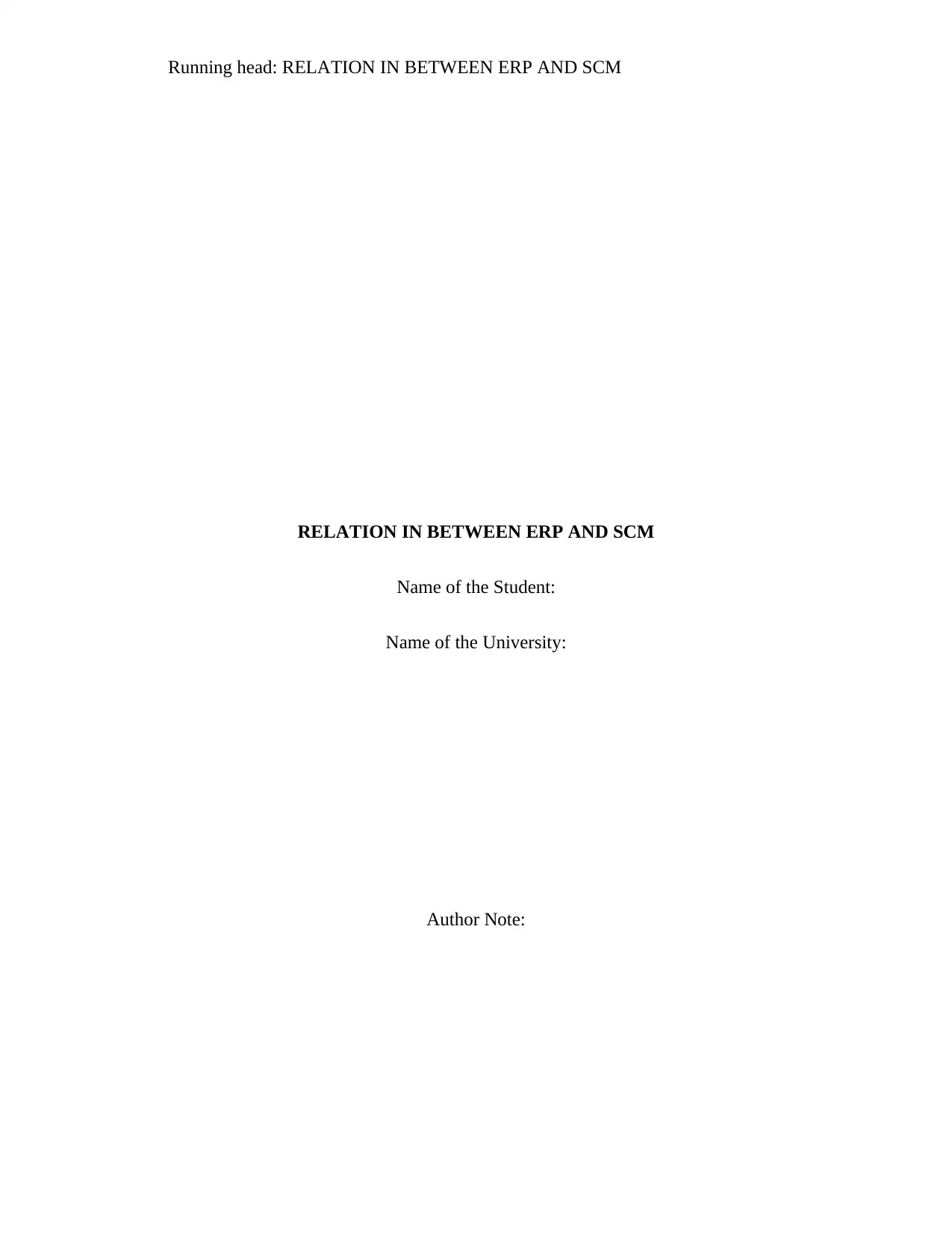
Running head: RELATION IN BETWEEN ERP AND SCM
RELATION IN BETWEEN ERP AND SCM
Name of the Student:
Name of the University:
Author Note:
RELATION IN BETWEEN ERP AND SCM
Name of the Student:
Name of the University:
Author Note:
Paraphrase This Document
Need a fresh take? Get an instant paraphrase of this document with our AI Paraphraser
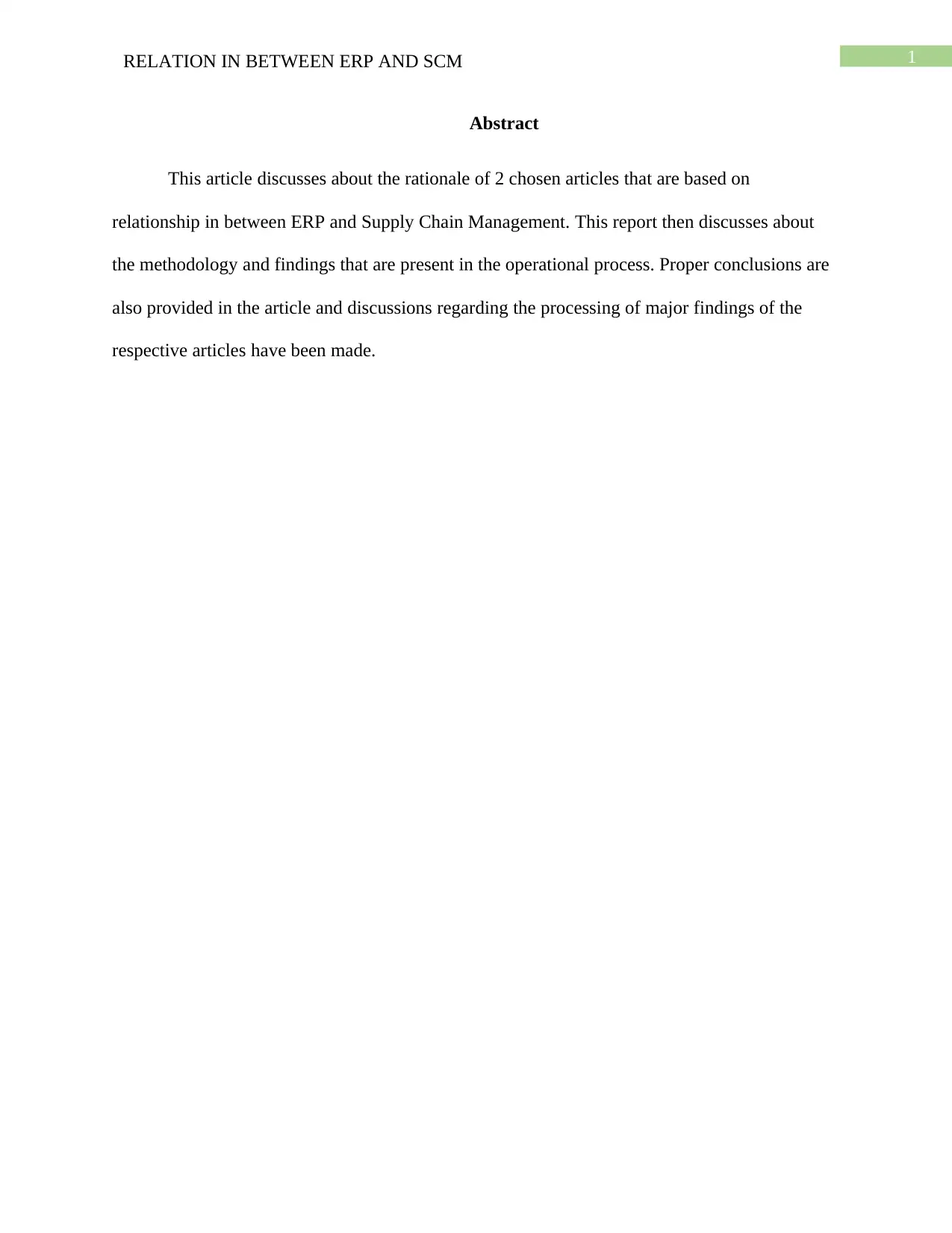
1RELATION IN BETWEEN ERP AND SCM
Abstract
This article discusses about the rationale of 2 chosen articles that are based on
relationship in between ERP and Supply Chain Management. This report then discusses about
the methodology and findings that are present in the operational process. Proper conclusions are
also provided in the article and discussions regarding the processing of major findings of the
respective articles have been made.
Abstract
This article discusses about the rationale of 2 chosen articles that are based on
relationship in between ERP and Supply Chain Management. This report then discusses about
the methodology and findings that are present in the operational process. Proper conclusions are
also provided in the article and discussions regarding the processing of major findings of the
respective articles have been made.
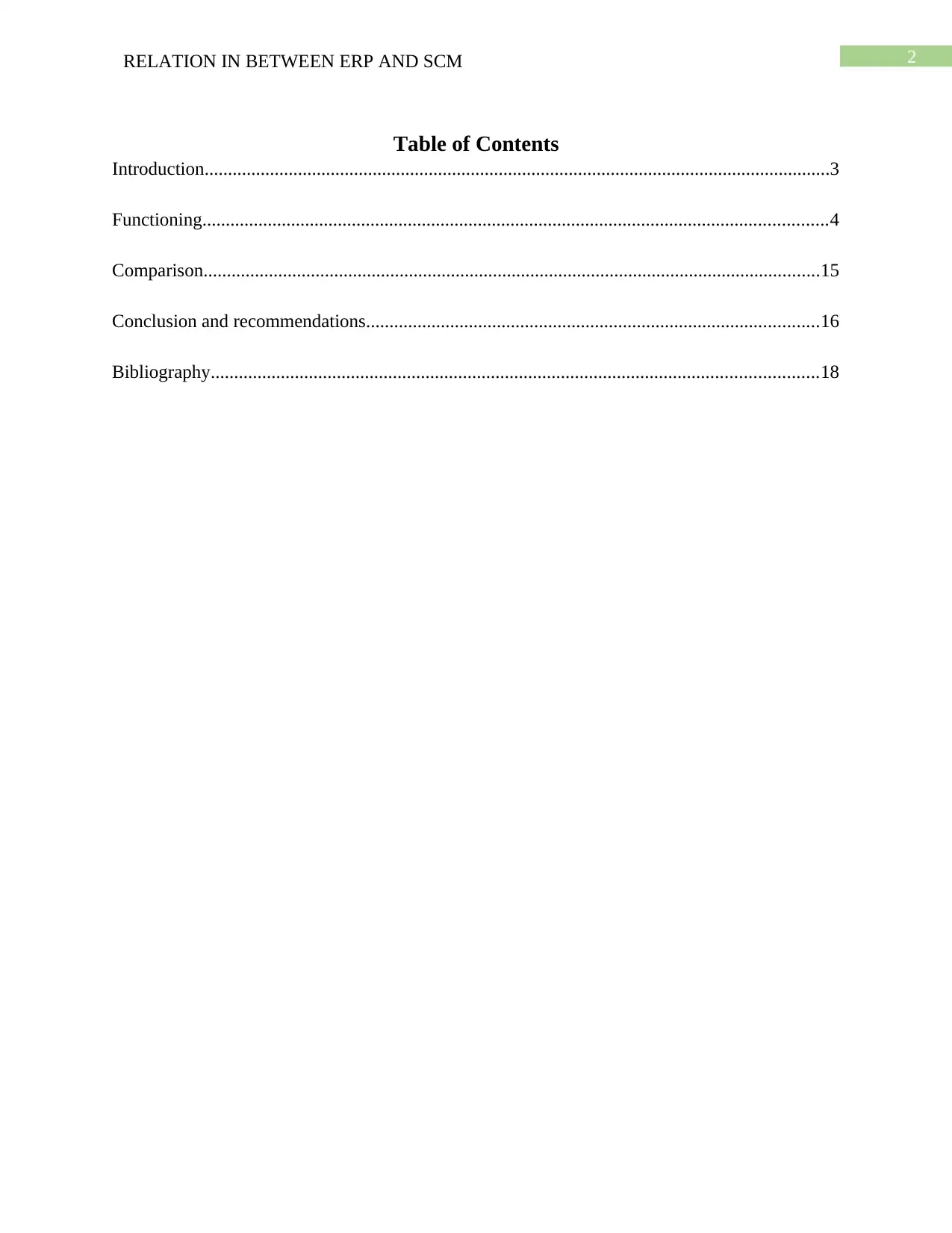
2RELATION IN BETWEEN ERP AND SCM
Table of Contents
Introduction......................................................................................................................................3
Functioning......................................................................................................................................4
Comparison....................................................................................................................................15
Conclusion and recommendations.................................................................................................16
Bibliography..................................................................................................................................18
Table of Contents
Introduction......................................................................................................................................3
Functioning......................................................................................................................................4
Comparison....................................................................................................................................15
Conclusion and recommendations.................................................................................................16
Bibliography..................................................................................................................................18
⊘ This is a preview!⊘
Do you want full access?
Subscribe today to unlock all pages.

Trusted by 1+ million students worldwide
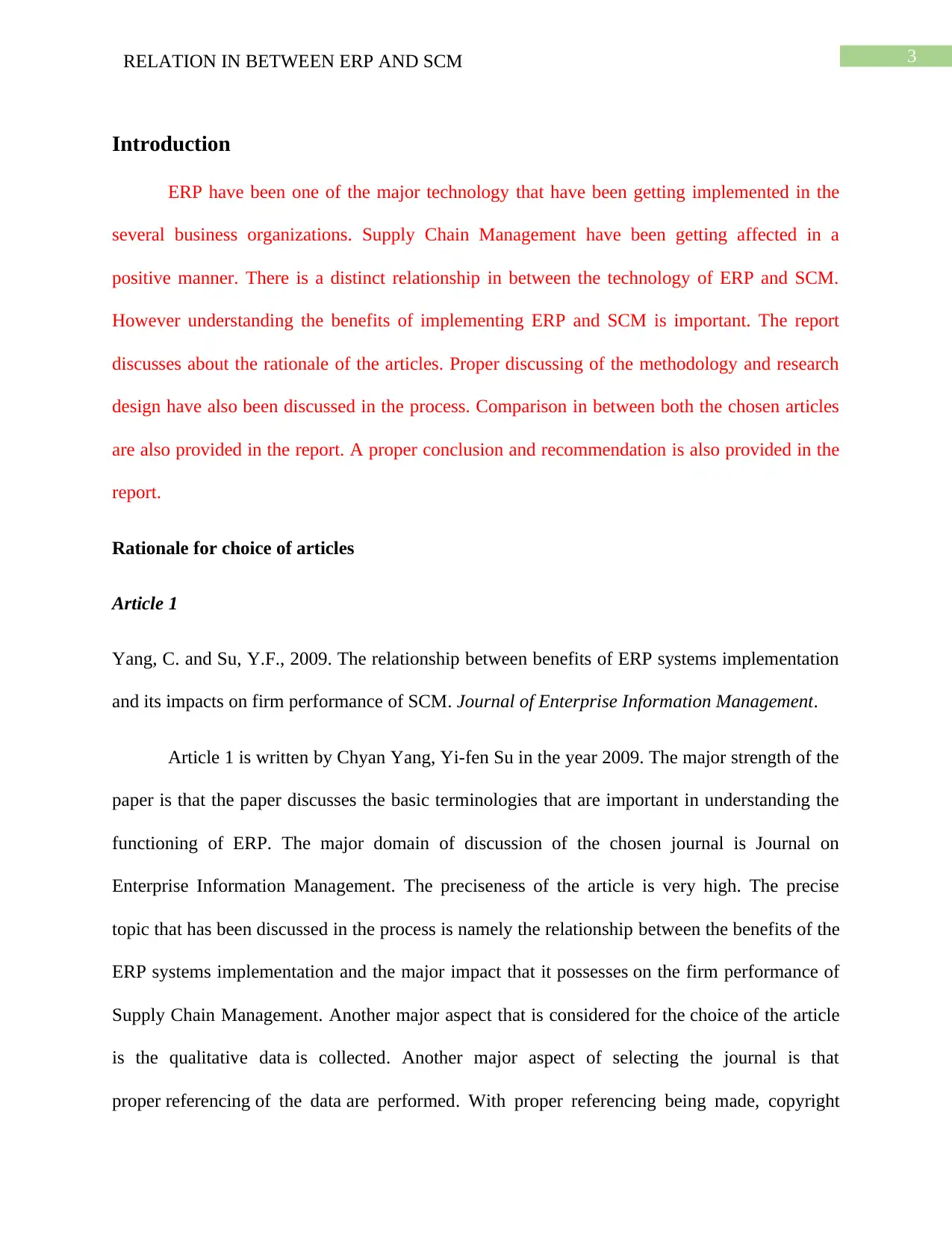
3RELATION IN BETWEEN ERP AND SCM
Introduction
ERP have been one of the major technology that have been getting implemented in the
several business organizations. Supply Chain Management have been getting affected in a
positive manner. There is a distinct relationship in between the technology of ERP and SCM.
However understanding the benefits of implementing ERP and SCM is important. The report
discusses about the rationale of the articles. Proper discussing of the methodology and research
design have also been discussed in the process. Comparison in between both the chosen articles
are also provided in the report. A proper conclusion and recommendation is also provided in the
report.
Rationale for choice of articles
Article 1
Yang, C. and Su, Y.F., 2009. The relationship between benefits of ERP systems implementation
and its impacts on firm performance of SCM. Journal of Enterprise Information Management.
Article 1 is written by Chyan Yang, Yi‐fen Su in the year 2009. The major strength of the
paper is that the paper discusses the basic terminologies that are important in understanding the
functioning of ERP. The major domain of discussion of the chosen journal is Journal on
Enterprise Information Management. The preciseness of the article is very high. The precise
topic that has been discussed in the process is namely the relationship between the benefits of the
ERP systems implementation and the major impact that it possesses on the firm performance of
Supply Chain Management. Another major aspect that is considered for the choice of the article
is the qualitative data is collected. Another major aspect of selecting the journal is that
proper referencing of the data are performed. With proper referencing being made, copyright
Introduction
ERP have been one of the major technology that have been getting implemented in the
several business organizations. Supply Chain Management have been getting affected in a
positive manner. There is a distinct relationship in between the technology of ERP and SCM.
However understanding the benefits of implementing ERP and SCM is important. The report
discusses about the rationale of the articles. Proper discussing of the methodology and research
design have also been discussed in the process. Comparison in between both the chosen articles
are also provided in the report. A proper conclusion and recommendation is also provided in the
report.
Rationale for choice of articles
Article 1
Yang, C. and Su, Y.F., 2009. The relationship between benefits of ERP systems implementation
and its impacts on firm performance of SCM. Journal of Enterprise Information Management.
Article 1 is written by Chyan Yang, Yi‐fen Su in the year 2009. The major strength of the
paper is that the paper discusses the basic terminologies that are important in understanding the
functioning of ERP. The major domain of discussion of the chosen journal is Journal on
Enterprise Information Management. The preciseness of the article is very high. The precise
topic that has been discussed in the process is namely the relationship between the benefits of the
ERP systems implementation and the major impact that it possesses on the firm performance of
Supply Chain Management. Another major aspect that is considered for the choice of the article
is the qualitative data is collected. Another major aspect of selecting the journal is that
proper referencing of the data are performed. With proper referencing being made, copyright
Paraphrase This Document
Need a fresh take? Get an instant paraphrase of this document with our AI Paraphraser
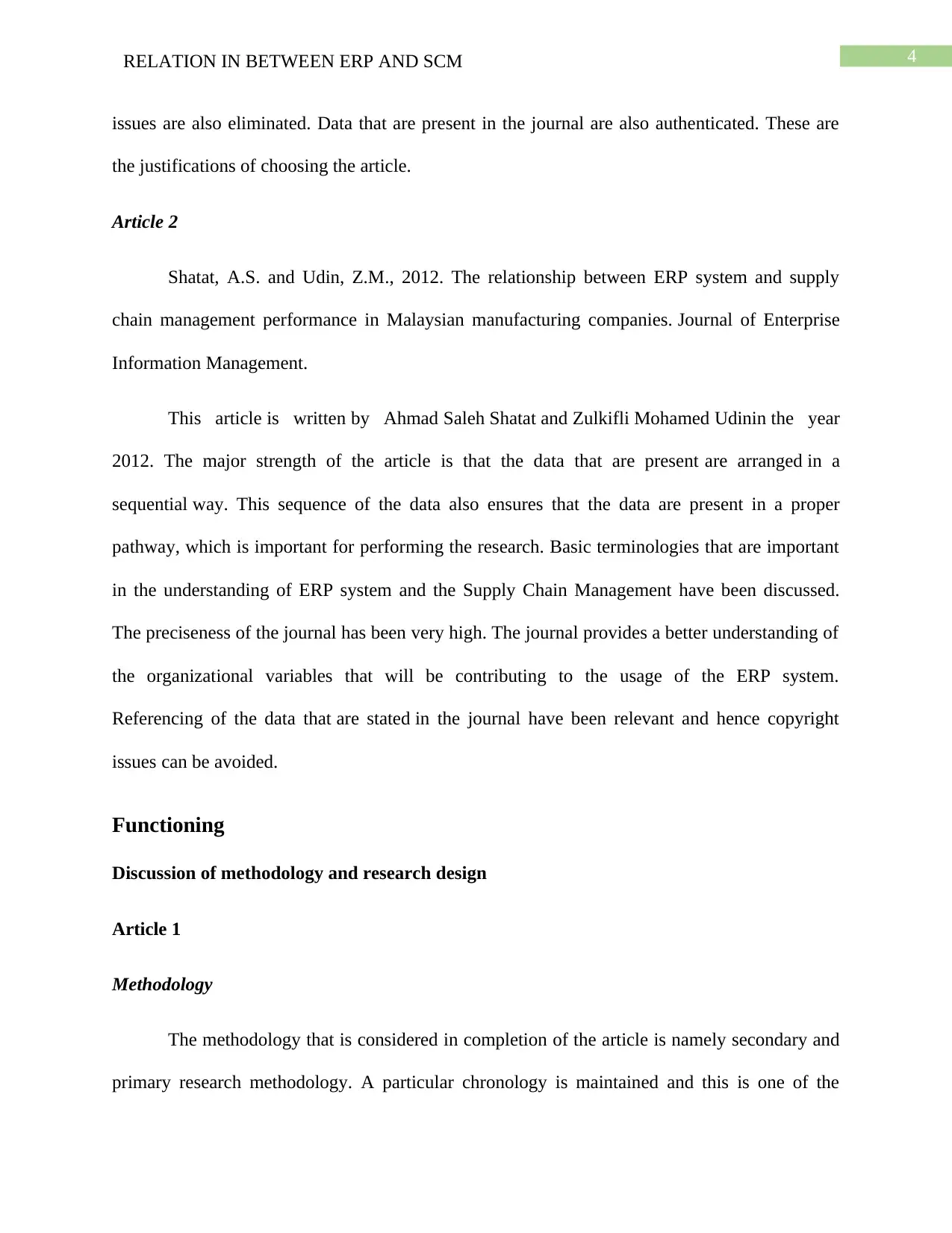
4RELATION IN BETWEEN ERP AND SCM
issues are also eliminated. Data that are present in the journal are also authenticated. These are
the justifications of choosing the article.
Article 2
Shatat, A.S. and Udin, Z.M., 2012. The relationship between ERP system and supply
chain management performance in Malaysian manufacturing companies. Journal of Enterprise
Information Management.
This article is written by Ahmad Saleh Shatat and Zulkifli Mohamed Udinin the year
2012. The major strength of the article is that the data that are present are arranged in a
sequential way. This sequence of the data also ensures that the data are present in a proper
pathway, which is important for performing the research. Basic terminologies that are important
in the understanding of ERP system and the Supply Chain Management have been discussed.
The preciseness of the journal has been very high. The journal provides a better understanding of
the organizational variables that will be contributing to the usage of the ERP system.
Referencing of the data that are stated in the journal have been relevant and hence copyright
issues can be avoided.
Functioning
Discussion of methodology and research design
Article 1
Methodology
The methodology that is considered in completion of the article is namely secondary and
primary research methodology. A particular chronology is maintained and this is one of the
issues are also eliminated. Data that are present in the journal are also authenticated. These are
the justifications of choosing the article.
Article 2
Shatat, A.S. and Udin, Z.M., 2012. The relationship between ERP system and supply
chain management performance in Malaysian manufacturing companies. Journal of Enterprise
Information Management.
This article is written by Ahmad Saleh Shatat and Zulkifli Mohamed Udinin the year
2012. The major strength of the article is that the data that are present are arranged in a
sequential way. This sequence of the data also ensures that the data are present in a proper
pathway, which is important for performing the research. Basic terminologies that are important
in the understanding of ERP system and the Supply Chain Management have been discussed.
The preciseness of the journal has been very high. The journal provides a better understanding of
the organizational variables that will be contributing to the usage of the ERP system.
Referencing of the data that are stated in the journal have been relevant and hence copyright
issues can be avoided.
Functioning
Discussion of methodology and research design
Article 1
Methodology
The methodology that is considered in completion of the article is namely secondary and
primary research methodology. A particular chronology is maintained and this is one of the
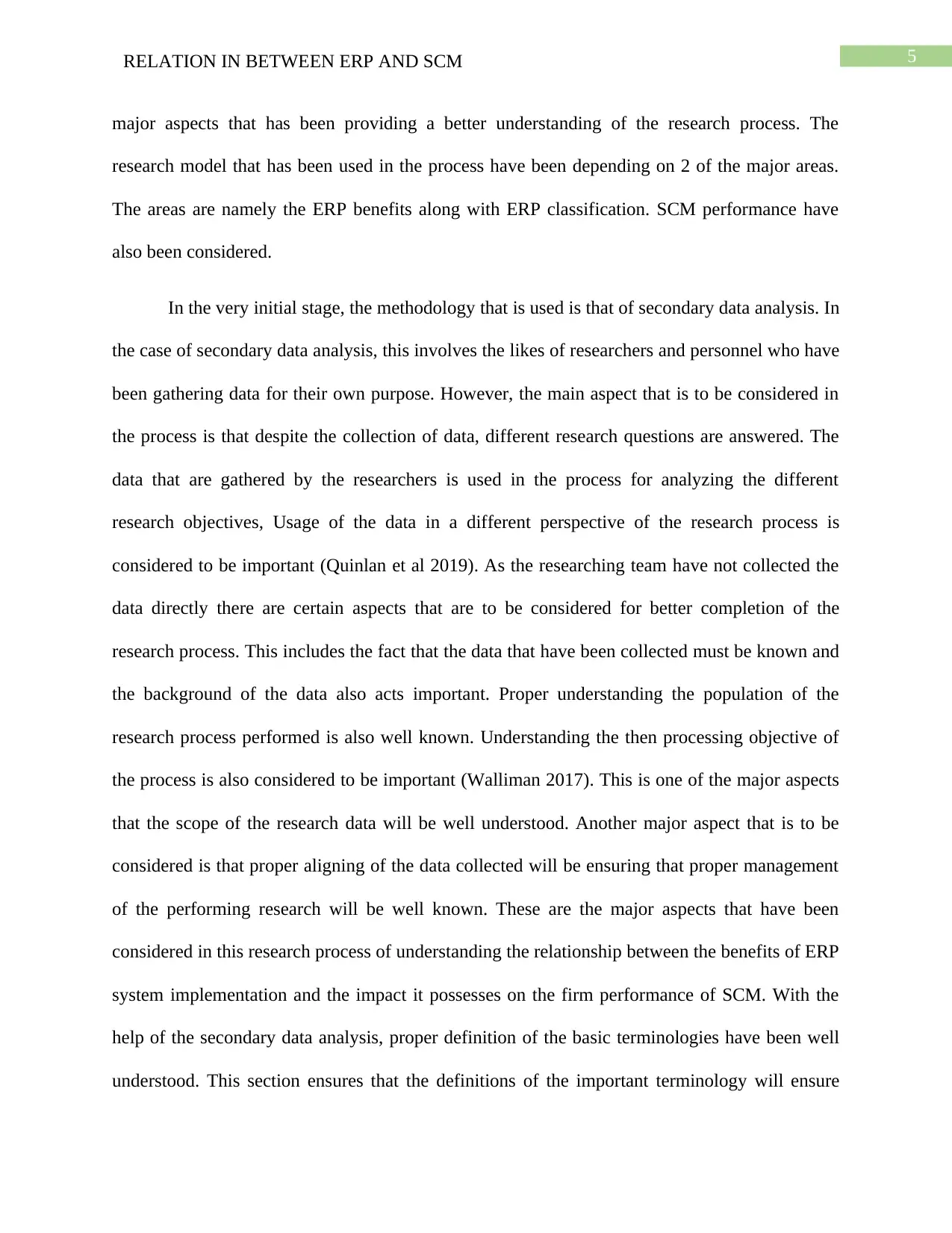
5RELATION IN BETWEEN ERP AND SCM
major aspects that has been providing a better understanding of the research process. The
research model that has been used in the process have been depending on 2 of the major areas.
The areas are namely the ERP benefits along with ERP classification. SCM performance have
also been considered.
In the very initial stage, the methodology that is used is that of secondary data analysis. In
the case of secondary data analysis, this involves the likes of researchers and personnel who have
been gathering data for their own purpose. However, the main aspect that is to be considered in
the process is that despite the collection of data, different research questions are answered. The
data that are gathered by the researchers is used in the process for analyzing the different
research objectives, Usage of the data in a different perspective of the research process is
considered to be important (Quinlan et al 2019). As the researching team have not collected the
data directly there are certain aspects that are to be considered for better completion of the
research process. This includes the fact that the data that have been collected must be known and
the background of the data also acts important. Proper understanding the population of the
research process performed is also well known. Understanding the then processing objective of
the process is also considered to be important (Walliman 2017). This is one of the major aspects
that the scope of the research data will be well understood. Another major aspect that is to be
considered is that proper aligning of the data collected will be ensuring that proper management
of the performing research will be well known. These are the major aspects that have been
considered in this research process of understanding the relationship between the benefits of ERP
system implementation and the impact it possesses on the firm performance of SCM. With the
help of the secondary data analysis, proper definition of the basic terminologies have been well
understood. This section ensures that the definitions of the important terminology will ensure
major aspects that has been providing a better understanding of the research process. The
research model that has been used in the process have been depending on 2 of the major areas.
The areas are namely the ERP benefits along with ERP classification. SCM performance have
also been considered.
In the very initial stage, the methodology that is used is that of secondary data analysis. In
the case of secondary data analysis, this involves the likes of researchers and personnel who have
been gathering data for their own purpose. However, the main aspect that is to be considered in
the process is that despite the collection of data, different research questions are answered. The
data that are gathered by the researchers is used in the process for analyzing the different
research objectives, Usage of the data in a different perspective of the research process is
considered to be important (Quinlan et al 2019). As the researching team have not collected the
data directly there are certain aspects that are to be considered for better completion of the
research process. This includes the fact that the data that have been collected must be known and
the background of the data also acts important. Proper understanding the population of the
research process performed is also well known. Understanding the then processing objective of
the process is also considered to be important (Walliman 2017). This is one of the major aspects
that the scope of the research data will be well understood. Another major aspect that is to be
considered is that proper aligning of the data collected will be ensuring that proper management
of the performing research will be well known. These are the major aspects that have been
considered in this research process of understanding the relationship between the benefits of ERP
system implementation and the impact it possesses on the firm performance of SCM. With the
help of the secondary data analysis, proper definition of the basic terminologies have been well
understood. This section ensures that the definitions of the important terminology will ensure
⊘ This is a preview!⊘
Do you want full access?
Subscribe today to unlock all pages.

Trusted by 1+ million students worldwide
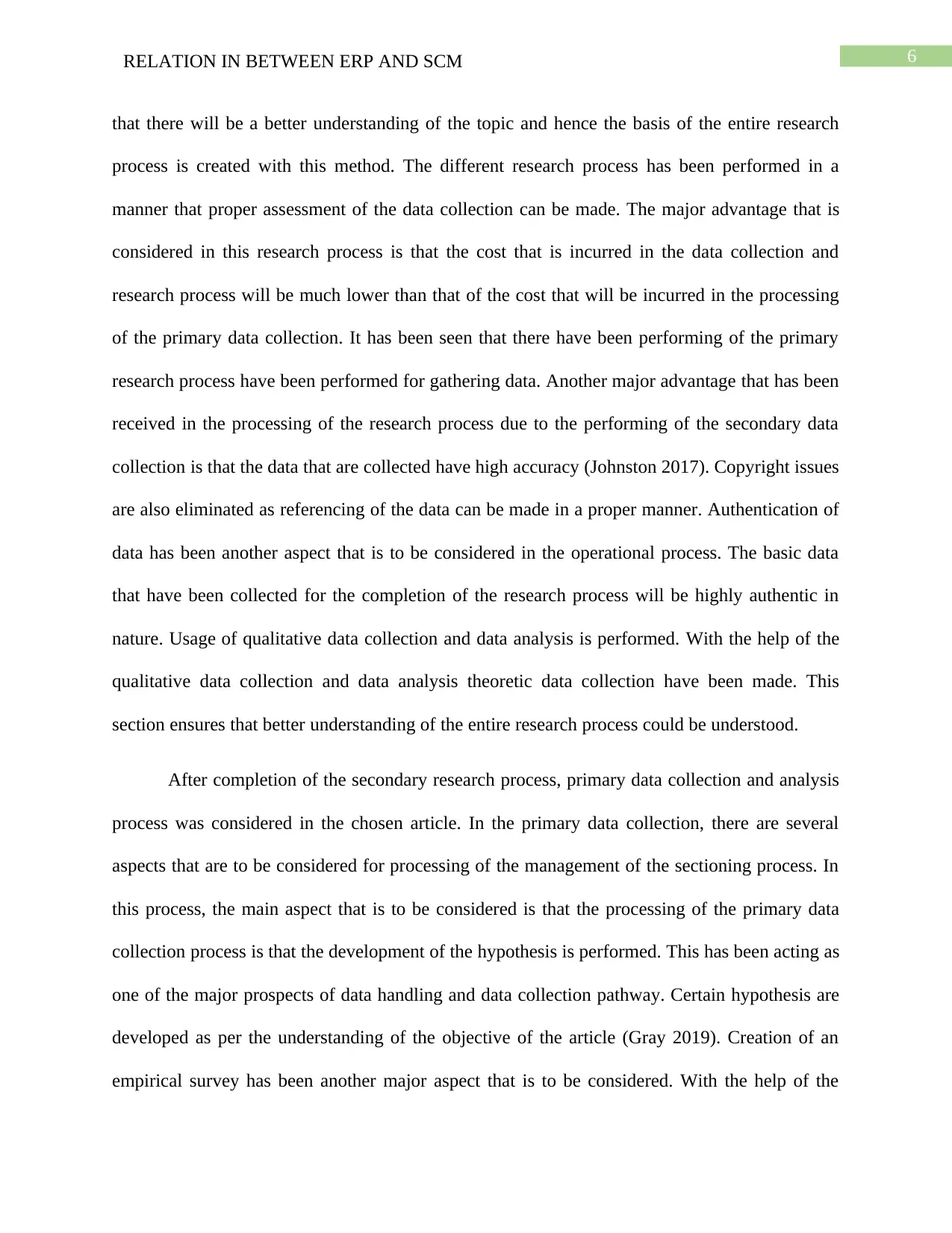
6RELATION IN BETWEEN ERP AND SCM
that there will be a better understanding of the topic and hence the basis of the entire research
process is created with this method. The different research process has been performed in a
manner that proper assessment of the data collection can be made. The major advantage that is
considered in this research process is that the cost that is incurred in the data collection and
research process will be much lower than that of the cost that will be incurred in the processing
of the primary data collection. It has been seen that there have been performing of the primary
research process have been performed for gathering data. Another major advantage that has been
received in the processing of the research process due to the performing of the secondary data
collection is that the data that are collected have high accuracy (Johnston 2017). Copyright issues
are also eliminated as referencing of the data can be made in a proper manner. Authentication of
data has been another aspect that is to be considered in the operational process. The basic data
that have been collected for the completion of the research process will be highly authentic in
nature. Usage of qualitative data collection and data analysis is performed. With the help of the
qualitative data collection and data analysis theoretic data collection have been made. This
section ensures that better understanding of the entire research process could be understood.
After completion of the secondary research process, primary data collection and analysis
process was considered in the chosen article. In the primary data collection, there are several
aspects that are to be considered for processing of the management of the sectioning process. In
this process, the main aspect that is to be considered is that the processing of the primary data
collection process is that the development of the hypothesis is performed. This has been acting as
one of the major prospects of data handling and data collection pathway. Certain hypothesis are
developed as per the understanding of the objective of the article (Gray 2019). Creation of an
empirical survey has been another major aspect that is to be considered. With the help of the
that there will be a better understanding of the topic and hence the basis of the entire research
process is created with this method. The different research process has been performed in a
manner that proper assessment of the data collection can be made. The major advantage that is
considered in this research process is that the cost that is incurred in the data collection and
research process will be much lower than that of the cost that will be incurred in the processing
of the primary data collection. It has been seen that there have been performing of the primary
research process have been performed for gathering data. Another major advantage that has been
received in the processing of the research process due to the performing of the secondary data
collection is that the data that are collected have high accuracy (Johnston 2017). Copyright issues
are also eliminated as referencing of the data can be made in a proper manner. Authentication of
data has been another aspect that is to be considered in the operational process. The basic data
that have been collected for the completion of the research process will be highly authentic in
nature. Usage of qualitative data collection and data analysis is performed. With the help of the
qualitative data collection and data analysis theoretic data collection have been made. This
section ensures that better understanding of the entire research process could be understood.
After completion of the secondary research process, primary data collection and analysis
process was considered in the chosen article. In the primary data collection, there are several
aspects that are to be considered for processing of the management of the sectioning process. In
this process, the main aspect that is to be considered is that the processing of the primary data
collection process is that the development of the hypothesis is performed. This has been acting as
one of the major prospects of data handling and data collection pathway. Certain hypothesis are
developed as per the understanding of the objective of the article (Gray 2019). Creation of an
empirical survey has been another major aspect that is to be considered. With the help of the
Paraphrase This Document
Need a fresh take? Get an instant paraphrase of this document with our AI Paraphraser
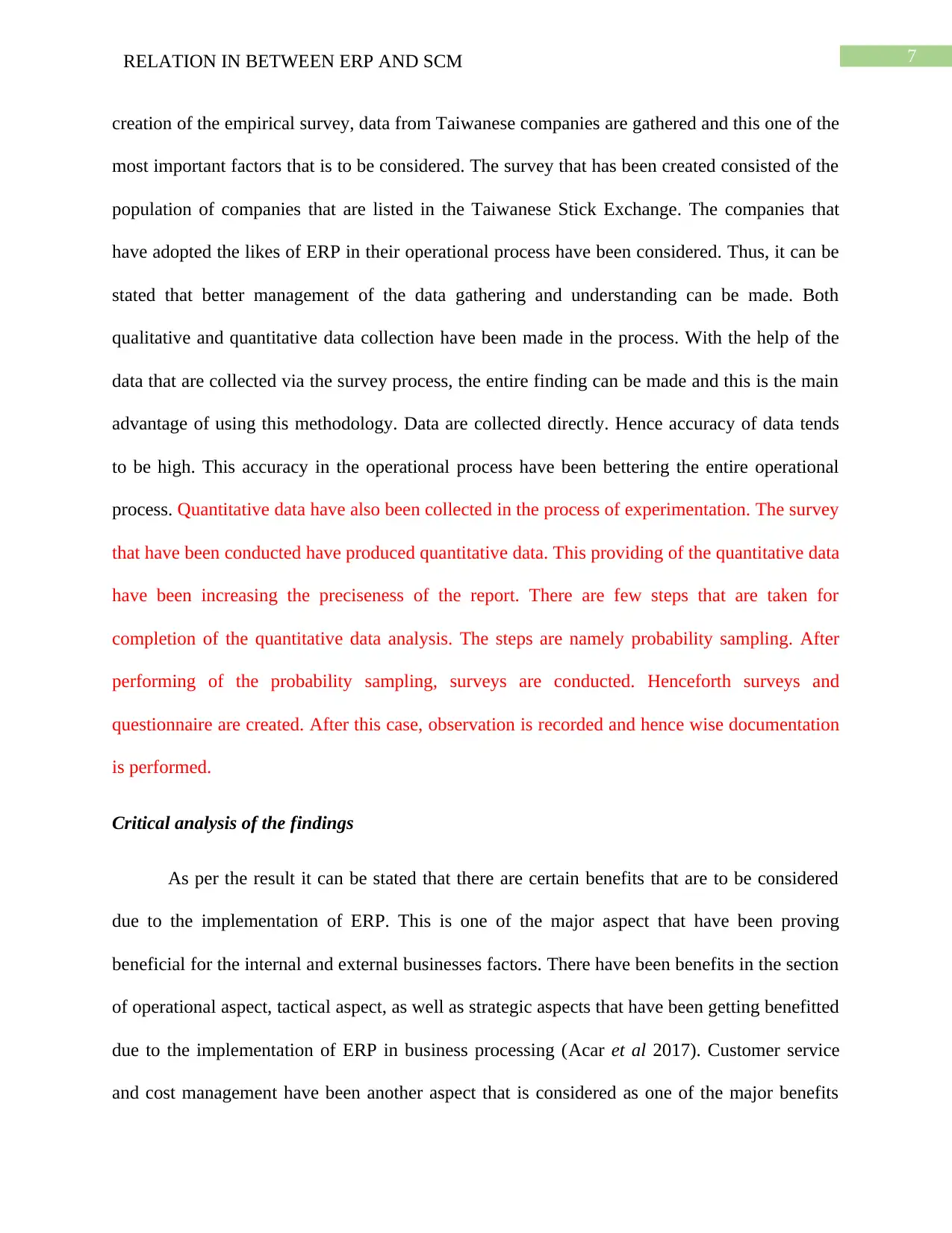
7RELATION IN BETWEEN ERP AND SCM
creation of the empirical survey, data from Taiwanese companies are gathered and this one of the
most important factors that is to be considered. The survey that has been created consisted of the
population of companies that are listed in the Taiwanese Stick Exchange. The companies that
have adopted the likes of ERP in their operational process have been considered. Thus, it can be
stated that better management of the data gathering and understanding can be made. Both
qualitative and quantitative data collection have been made in the process. With the help of the
data that are collected via the survey process, the entire finding can be made and this is the main
advantage of using this methodology. Data are collected directly. Hence accuracy of data tends
to be high. This accuracy in the operational process have been bettering the entire operational
process. Quantitative data have also been collected in the process of experimentation. The survey
that have been conducted have produced quantitative data. This providing of the quantitative data
have been increasing the preciseness of the report. There are few steps that are taken for
completion of the quantitative data analysis. The steps are namely probability sampling. After
performing of the probability sampling, surveys are conducted. Henceforth surveys and
questionnaire are created. After this case, observation is recorded and hence wise documentation
is performed.
Critical analysis of the findings
As per the result it can be stated that there are certain benefits that are to be considered
due to the implementation of ERP. This is one of the major aspect that have been proving
beneficial for the internal and external businesses factors. There have been benefits in the section
of operational aspect, tactical aspect, as well as strategic aspects that have been getting benefitted
due to the implementation of ERP in business processing (Acar et al 2017). Customer service
and cost management have been another aspect that is considered as one of the major benefits
creation of the empirical survey, data from Taiwanese companies are gathered and this one of the
most important factors that is to be considered. The survey that has been created consisted of the
population of companies that are listed in the Taiwanese Stick Exchange. The companies that
have adopted the likes of ERP in their operational process have been considered. Thus, it can be
stated that better management of the data gathering and understanding can be made. Both
qualitative and quantitative data collection have been made in the process. With the help of the
data that are collected via the survey process, the entire finding can be made and this is the main
advantage of using this methodology. Data are collected directly. Hence accuracy of data tends
to be high. This accuracy in the operational process have been bettering the entire operational
process. Quantitative data have also been collected in the process of experimentation. The survey
that have been conducted have produced quantitative data. This providing of the quantitative data
have been increasing the preciseness of the report. There are few steps that are taken for
completion of the quantitative data analysis. The steps are namely probability sampling. After
performing of the probability sampling, surveys are conducted. Henceforth surveys and
questionnaire are created. After this case, observation is recorded and hence wise documentation
is performed.
Critical analysis of the findings
As per the result it can be stated that there are certain benefits that are to be considered
due to the implementation of ERP. This is one of the major aspect that have been proving
beneficial for the internal and external businesses factors. There have been benefits in the section
of operational aspect, tactical aspect, as well as strategic aspects that have been getting benefitted
due to the implementation of ERP in business processing (Acar et al 2017). Customer service
and cost management have been another aspect that is considered as one of the major benefits
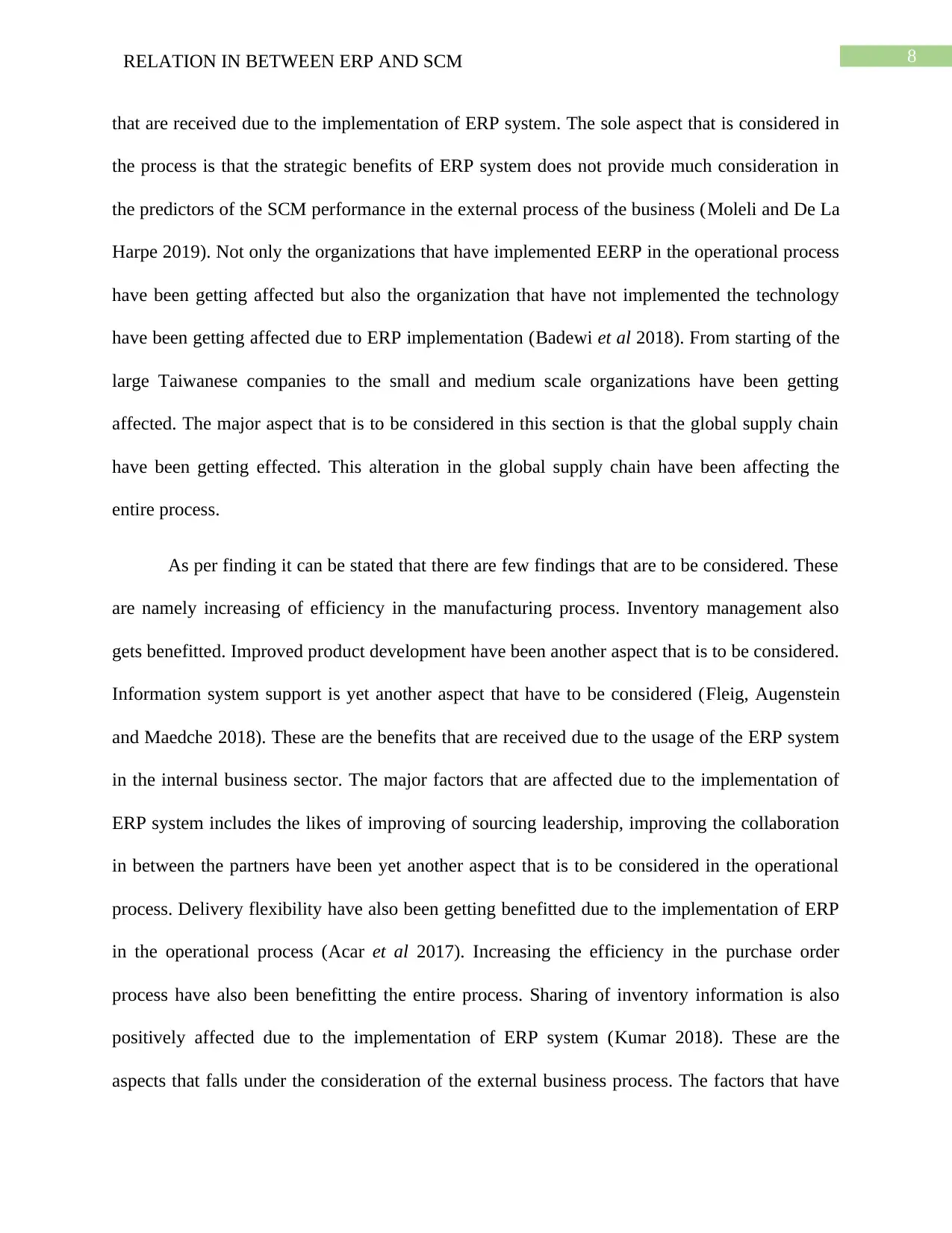
8RELATION IN BETWEEN ERP AND SCM
that are received due to the implementation of ERP system. The sole aspect that is considered in
the process is that the strategic benefits of ERP system does not provide much consideration in
the predictors of the SCM performance in the external process of the business (Moleli and De La
Harpe 2019). Not only the organizations that have implemented EERP in the operational process
have been getting affected but also the organization that have not implemented the technology
have been getting affected due to ERP implementation (Badewi et al 2018). From starting of the
large Taiwanese companies to the small and medium scale organizations have been getting
affected. The major aspect that is to be considered in this section is that the global supply chain
have been getting effected. This alteration in the global supply chain have been affecting the
entire process.
As per finding it can be stated that there are few findings that are to be considered. These
are namely increasing of efficiency in the manufacturing process. Inventory management also
gets benefitted. Improved product development have been another aspect that is to be considered.
Information system support is yet another aspect that have to be considered (Fleig, Augenstein
and Maedche 2018). These are the benefits that are received due to the usage of the ERP system
in the internal business sector. The major factors that are affected due to the implementation of
ERP system includes the likes of improving of sourcing leadership, improving the collaboration
in between the partners have been yet another aspect that is to be considered in the operational
process. Delivery flexibility have also been getting benefitted due to the implementation of ERP
in the operational process (Acar et al 2017). Increasing the efficiency in the purchase order
process have also been benefitting the entire process. Sharing of inventory information is also
positively affected due to the implementation of ERP system (Kumar 2018). These are the
aspects that falls under the consideration of the external business process. The factors that have
that are received due to the implementation of ERP system. The sole aspect that is considered in
the process is that the strategic benefits of ERP system does not provide much consideration in
the predictors of the SCM performance in the external process of the business (Moleli and De La
Harpe 2019). Not only the organizations that have implemented EERP in the operational process
have been getting affected but also the organization that have not implemented the technology
have been getting affected due to ERP implementation (Badewi et al 2018). From starting of the
large Taiwanese companies to the small and medium scale organizations have been getting
affected. The major aspect that is to be considered in this section is that the global supply chain
have been getting effected. This alteration in the global supply chain have been affecting the
entire process.
As per finding it can be stated that there are few findings that are to be considered. These
are namely increasing of efficiency in the manufacturing process. Inventory management also
gets benefitted. Improved product development have been another aspect that is to be considered.
Information system support is yet another aspect that have to be considered (Fleig, Augenstein
and Maedche 2018). These are the benefits that are received due to the usage of the ERP system
in the internal business sector. The major factors that are affected due to the implementation of
ERP system includes the likes of improving of sourcing leadership, improving the collaboration
in between the partners have been yet another aspect that is to be considered in the operational
process. Delivery flexibility have also been getting benefitted due to the implementation of ERP
in the operational process (Acar et al 2017). Increasing the efficiency in the purchase order
process have also been benefitting the entire process. Sharing of inventory information is also
positively affected due to the implementation of ERP system (Kumar 2018). These are the
aspects that falls under the consideration of the external business process. The factors that have
⊘ This is a preview!⊘
Do you want full access?
Subscribe today to unlock all pages.

Trusted by 1+ million students worldwide
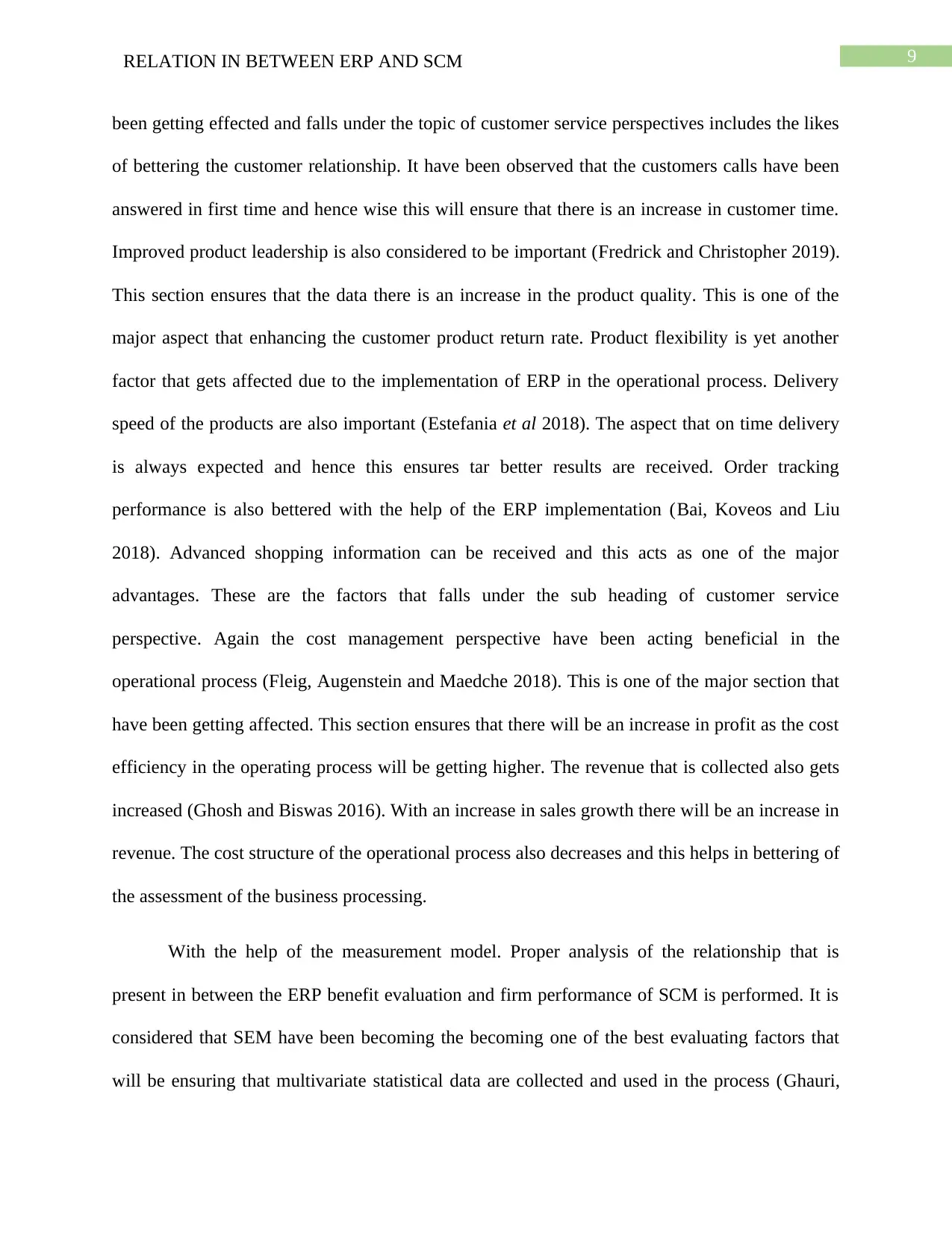
9RELATION IN BETWEEN ERP AND SCM
been getting effected and falls under the topic of customer service perspectives includes the likes
of bettering the customer relationship. It have been observed that the customers calls have been
answered in first time and hence wise this will ensure that there is an increase in customer time.
Improved product leadership is also considered to be important (Fredrick and Christopher 2019).
This section ensures that the data there is an increase in the product quality. This is one of the
major aspect that enhancing the customer product return rate. Product flexibility is yet another
factor that gets affected due to the implementation of ERP in the operational process. Delivery
speed of the products are also important (Estefania et al 2018). The aspect that on time delivery
is always expected and hence this ensures tar better results are received. Order tracking
performance is also bettered with the help of the ERP implementation (Bai, Koveos and Liu
2018). Advanced shopping information can be received and this acts as one of the major
advantages. These are the factors that falls under the sub heading of customer service
perspective. Again the cost management perspective have been acting beneficial in the
operational process (Fleig, Augenstein and Maedche 2018). This is one of the major section that
have been getting affected. This section ensures that there will be an increase in profit as the cost
efficiency in the operating process will be getting higher. The revenue that is collected also gets
increased (Ghosh and Biswas 2016). With an increase in sales growth there will be an increase in
revenue. The cost structure of the operational process also decreases and this helps in bettering of
the assessment of the business processing.
With the help of the measurement model. Proper analysis of the relationship that is
present in between the ERP benefit evaluation and firm performance of SCM is performed. It is
considered that SEM have been becoming the becoming one of the best evaluating factors that
will be ensuring that multivariate statistical data are collected and used in the process (Ghauri,
been getting effected and falls under the topic of customer service perspectives includes the likes
of bettering the customer relationship. It have been observed that the customers calls have been
answered in first time and hence wise this will ensure that there is an increase in customer time.
Improved product leadership is also considered to be important (Fredrick and Christopher 2019).
This section ensures that the data there is an increase in the product quality. This is one of the
major aspect that enhancing the customer product return rate. Product flexibility is yet another
factor that gets affected due to the implementation of ERP in the operational process. Delivery
speed of the products are also important (Estefania et al 2018). The aspect that on time delivery
is always expected and hence this ensures tar better results are received. Order tracking
performance is also bettered with the help of the ERP implementation (Bai, Koveos and Liu
2018). Advanced shopping information can be received and this acts as one of the major
advantages. These are the factors that falls under the sub heading of customer service
perspective. Again the cost management perspective have been acting beneficial in the
operational process (Fleig, Augenstein and Maedche 2018). This is one of the major section that
have been getting affected. This section ensures that there will be an increase in profit as the cost
efficiency in the operating process will be getting higher. The revenue that is collected also gets
increased (Ghosh and Biswas 2016). With an increase in sales growth there will be an increase in
revenue. The cost structure of the operational process also decreases and this helps in bettering of
the assessment of the business processing.
With the help of the measurement model. Proper analysis of the relationship that is
present in between the ERP benefit evaluation and firm performance of SCM is performed. It is
considered that SEM have been becoming the becoming one of the best evaluating factors that
will be ensuring that multivariate statistical data are collected and used in the process (Ghauri,
Paraphrase This Document
Need a fresh take? Get an instant paraphrase of this document with our AI Paraphraser
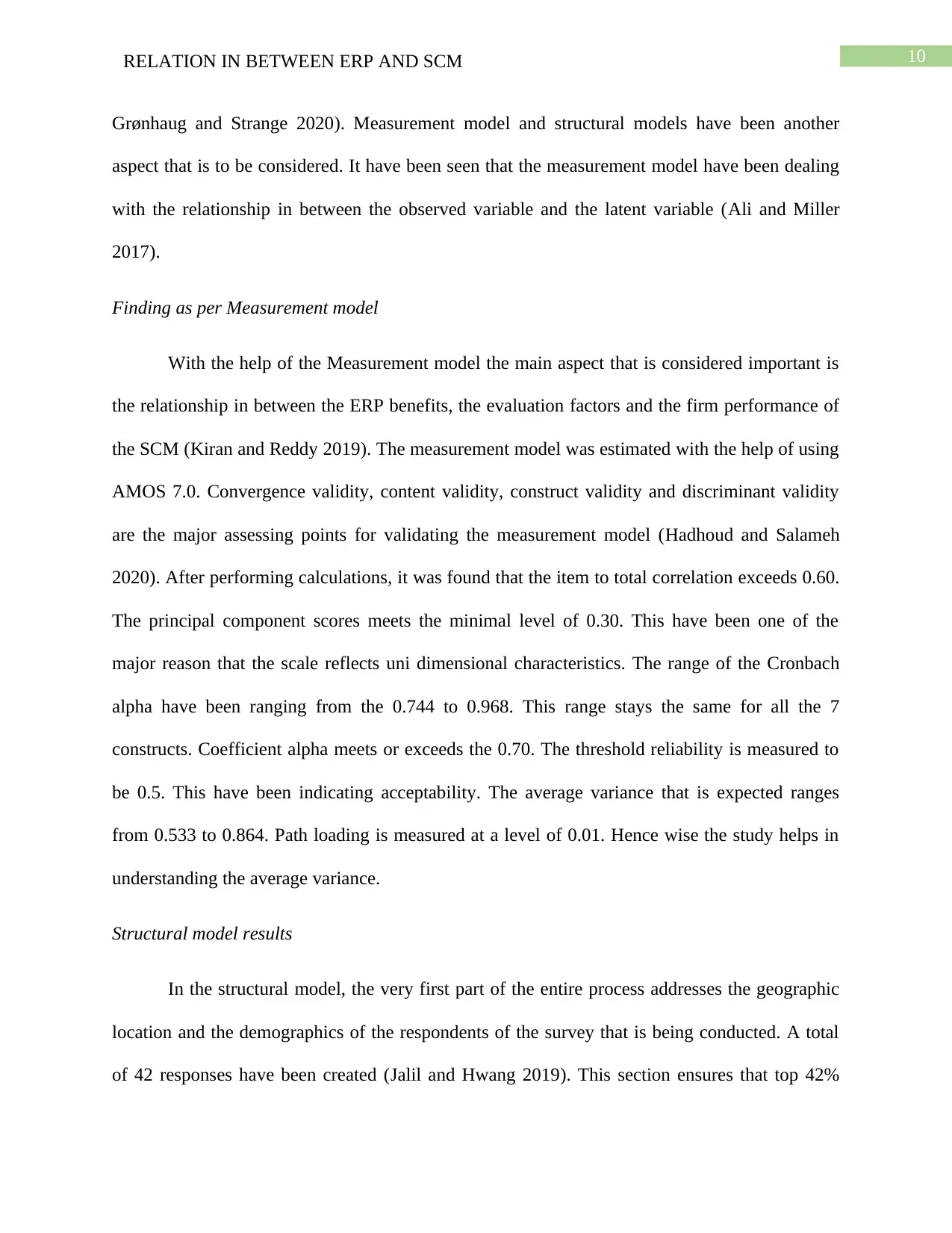
10RELATION IN BETWEEN ERP AND SCM
Grønhaug and Strange 2020). Measurement model and structural models have been another
aspect that is to be considered. It have been seen that the measurement model have been dealing
with the relationship in between the observed variable and the latent variable (Ali and Miller
2017).
Finding as per Measurement model
With the help of the Measurement model the main aspect that is considered important is
the relationship in between the ERP benefits, the evaluation factors and the firm performance of
the SCM (Kiran and Reddy 2019). The measurement model was estimated with the help of using
AMOS 7.0. Convergence validity, content validity, construct validity and discriminant validity
are the major assessing points for validating the measurement model (Hadhoud and Salameh
2020). After performing calculations, it was found that the item to total correlation exceeds 0.60.
The principal component scores meets the minimal level of 0.30. This have been one of the
major reason that the scale reflects uni dimensional characteristics. The range of the Cronbach
alpha have been ranging from the 0.744 to 0.968. This range stays the same for all the 7
constructs. Coefficient alpha meets or exceeds the 0.70. The threshold reliability is measured to
be 0.5. This have been indicating acceptability. The average variance that is expected ranges
from 0.533 to 0.864. Path loading is measured at a level of 0.01. Hence wise the study helps in
understanding the average variance.
Structural model results
In the structural model, the very first part of the entire process addresses the geographic
location and the demographics of the respondents of the survey that is being conducted. A total
of 42 responses have been created (Jalil and Hwang 2019). This section ensures that top 42%
Grønhaug and Strange 2020). Measurement model and structural models have been another
aspect that is to be considered. It have been seen that the measurement model have been dealing
with the relationship in between the observed variable and the latent variable (Ali and Miller
2017).
Finding as per Measurement model
With the help of the Measurement model the main aspect that is considered important is
the relationship in between the ERP benefits, the evaluation factors and the firm performance of
the SCM (Kiran and Reddy 2019). The measurement model was estimated with the help of using
AMOS 7.0. Convergence validity, content validity, construct validity and discriminant validity
are the major assessing points for validating the measurement model (Hadhoud and Salameh
2020). After performing calculations, it was found that the item to total correlation exceeds 0.60.
The principal component scores meets the minimal level of 0.30. This have been one of the
major reason that the scale reflects uni dimensional characteristics. The range of the Cronbach
alpha have been ranging from the 0.744 to 0.968. This range stays the same for all the 7
constructs. Coefficient alpha meets or exceeds the 0.70. The threshold reliability is measured to
be 0.5. This have been indicating acceptability. The average variance that is expected ranges
from 0.533 to 0.864. Path loading is measured at a level of 0.01. Hence wise the study helps in
understanding the average variance.
Structural model results
In the structural model, the very first part of the entire process addresses the geographic
location and the demographics of the respondents of the survey that is being conducted. A total
of 42 responses have been created (Jalil and Hwang 2019). This section ensures that top 42%
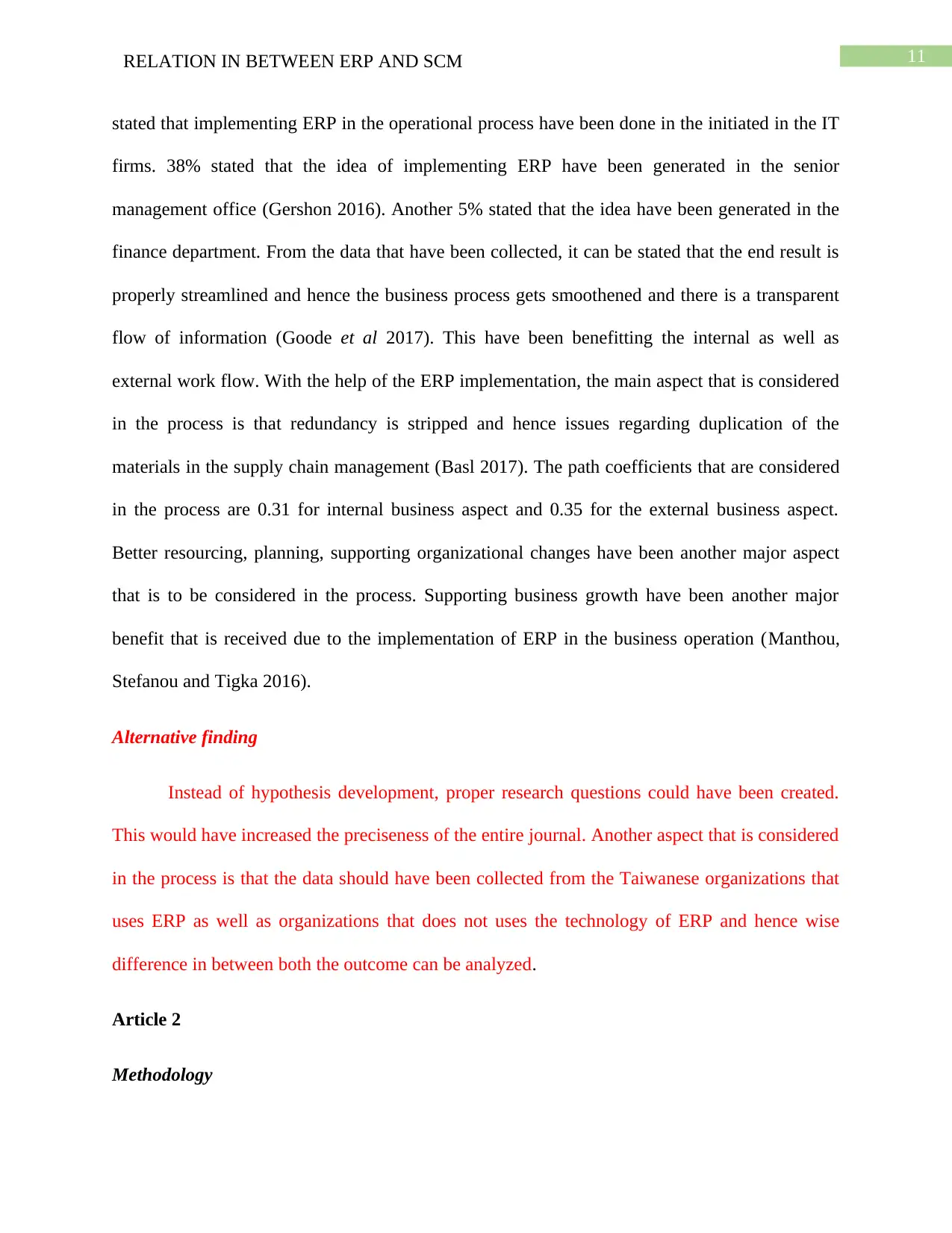
11RELATION IN BETWEEN ERP AND SCM
stated that implementing ERP in the operational process have been done in the initiated in the IT
firms. 38% stated that the idea of implementing ERP have been generated in the senior
management office (Gershon 2016). Another 5% stated that the idea have been generated in the
finance department. From the data that have been collected, it can be stated that the end result is
properly streamlined and hence the business process gets smoothened and there is a transparent
flow of information (Goode et al 2017). This have been benefitting the internal as well as
external work flow. With the help of the ERP implementation, the main aspect that is considered
in the process is that redundancy is stripped and hence issues regarding duplication of the
materials in the supply chain management (Basl 2017). The path coefficients that are considered
in the process are 0.31 for internal business aspect and 0.35 for the external business aspect.
Better resourcing, planning, supporting organizational changes have been another major aspect
that is to be considered in the process. Supporting business growth have been another major
benefit that is received due to the implementation of ERP in the business operation (Manthou,
Stefanou and Tigka 2016).
Alternative finding
Instead of hypothesis development, proper research questions could have been created.
This would have increased the preciseness of the entire journal. Another aspect that is considered
in the process is that the data should have been collected from the Taiwanese organizations that
uses ERP as well as organizations that does not uses the technology of ERP and hence wise
difference in between both the outcome can be analyzed.
Article 2
Methodology
stated that implementing ERP in the operational process have been done in the initiated in the IT
firms. 38% stated that the idea of implementing ERP have been generated in the senior
management office (Gershon 2016). Another 5% stated that the idea have been generated in the
finance department. From the data that have been collected, it can be stated that the end result is
properly streamlined and hence the business process gets smoothened and there is a transparent
flow of information (Goode et al 2017). This have been benefitting the internal as well as
external work flow. With the help of the ERP implementation, the main aspect that is considered
in the process is that redundancy is stripped and hence issues regarding duplication of the
materials in the supply chain management (Basl 2017). The path coefficients that are considered
in the process are 0.31 for internal business aspect and 0.35 for the external business aspect.
Better resourcing, planning, supporting organizational changes have been another major aspect
that is to be considered in the process. Supporting business growth have been another major
benefit that is received due to the implementation of ERP in the business operation (Manthou,
Stefanou and Tigka 2016).
Alternative finding
Instead of hypothesis development, proper research questions could have been created.
This would have increased the preciseness of the entire journal. Another aspect that is considered
in the process is that the data should have been collected from the Taiwanese organizations that
uses ERP as well as organizations that does not uses the technology of ERP and hence wise
difference in between both the outcome can be analyzed.
Article 2
Methodology
⊘ This is a preview!⊘
Do you want full access?
Subscribe today to unlock all pages.

Trusted by 1+ million students worldwide
1 out of 28
Related Documents
Your All-in-One AI-Powered Toolkit for Academic Success.
+13062052269
info@desklib.com
Available 24*7 on WhatsApp / Email
![[object Object]](/_next/static/media/star-bottom.7253800d.svg)
Unlock your academic potential
Copyright © 2020–2025 A2Z Services. All Rights Reserved. Developed and managed by ZUCOL.



